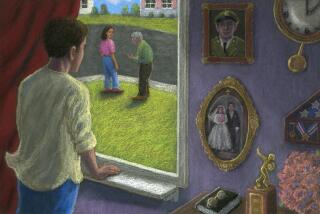The Murder That Haunted a Dream : SINS OF THE FATHER, <i> By Eileen Franklin and William Wright (Crown Publishers: $22; 353 pp.)</i>
- Share via
The story of Eileen Franklin and her murderous, sexually abusive father has the quality of a nightmare, and indeed it revealed itself to her in the form of a daydream. While staring into the face of her young daughter Jessica one afternoon in January, 1989, the 28-year-old Southern Californian suddenly was seized by a horrible vision. Eileen Franklin immediately understood that what she had just seen was the repressed memory of having witnessed the rape and murder of her best friend, 8-year-old Susan Nason. The crime, which occurred in Foster City, Calif., on Sept. 22, 1969, had never been solved.
Now, 20 years later, Eileen Franklin came to the realization that she knew the murderer. It was her own father, George Franklin, a man she very much loved despite the fact that he beat and sexually abused his wife and five children, including Eileen herself. She now remembered hearing her friend’s tortured “No, don’t!”; remembered the rock coming down on Susan’s head; remembered the disposal of the body; remembered, at last, her father’s admonition to tell no one, or else he would kill her as well.
“Sins of the Father,” co-authored by Eileen Franklin and veteran nonfiction writer William Wright, is a faithful rendering of how the Franklin case unfolded. Almost half of the text is devoted to the trial of George Franklin, who was found guilty of murder by a San Mateo jury last year and sentenced to life in prison. But it is as much a story of the paralyzing power of memories. Though Eileen Franklin says that she wrote this book with some reluctance, recognizing that her story would be told by someone whether she liked it or not, she has described the pathos of the haunted victim with unsparing honesty.
There is nothing simple about this story. Though George Franklin sexually abused his daughter Eileen, he also loved her the most of his five children, and often spared her the violence he inflicted on other household members. For Eileen, the abuses stopped altogether after Susan Nason’s murder, and for years thereafter, father and daughter remained close, even traveling together as a twosome.
As she grew up, Eileen remembered nothing about her past save the beatings, and so did not draw a connection between her nightmares and the malaise (poor grades, drug addiction and finally prostitution) that had overtaken her life. Certainly after departing that world for the calm suburban life of a wife and a mother of two, Eileen Franklin had no reason to suspect that an inner darkness would rear up and claim her.
Eileen Franklin’s decision to pursue the case against her father brought her a host of unwanted publicity and the demolition of her private life. The immediate effect was to polarize the Franklin family into two camps, with her mother and her sister Janice supporting the prosecution, and the rest either refusing to cooperate or assisting their father’s defense.
It is a measure of Eileen Franklin’s maturity and compassion that she does not use this book as an opportunity to lash out at the siblings who opposed her. Instead, she reminds us that each family member dealt with the terrors of the household as an individual. There is even a note of envy in her tone as she explains how her brother, George Jr., had put the memory of beatings behind him. But could he have done so had the memories included watching his father murder his best friend? The author presses this point ever so gently, reluctant to punish a fellow victim.
Eileen Franklin’s first-person insights constitute perhaps half of the text in all. The other half consists of William Wright’s more straightforward narrative. Presumably we are expected to trust him as the more objective of the co-authors; yet he, too, has his obvious biases. Beyond his natural admiration of his co-author, Wright embraces George Franklin’s prosecutor, San Mateo County Asst. Dist. Atty. Elaine Tipton, as the heroine of the tale. He generally avoids dwelling on the shortcomings of Tipton’s performance--such as her hotheaded cross-examination of George Jr.--while gleefully elaborating on the miscues of defense attorney, Douglas Horngrad, who apparently declined to be interviewed by Wright.
In telling the tale, Wright shows laudable restraint: He is well aware that this story requires no embellishment, and therefore sticks closely to the facts. (He does, however, tend to exaggerate the beauty of the Franklin sisters--who are certainly attractive--and to dwell on this matter as if it were somehow pertinent to the case.)
Indeed, facts are what “Sins of the Father” could use more of--above all, facts that might provide insight into the twisted psyche of George Franklin. Apparently through family interviews, Wright learned that George’s father was himself a violent man, though whether this mean streak involved sexual abuse is not made clear. Nor does Wright give us any sense of what George Franklin was up to during the years that he was estranged from Eileen and the rest of his family. Considering that the San Mateo County district attorney’s office is currently investigating George Franklin for other crimes, it would seem that these years were worth exploring. If Wright did so, he has nothing to show for his efforts.
Although his narrative aids the book’s pace, “Sins of the Father” sets itself apart from other true-crime thrillers primarily through the fascinating and scarifying sections written by Eileen Franklin herself. Her honesty in describing how the nightmare of her past has drawn itself over her life leaves the reader devastated. There’s no easy exit here: George Franklin may be behind bars, but he has left behind a woman who has lost all faith in religion, in family relationships and in the resiliency of traditional values. Memories of her past continue to visit her, bringing on, she says, “a fresh avalanche of pain.” These memories entangle themselves with memories that no one but she can appreciate: the distinct and abiding memories of George Franklin as a father who loved her--so much that he let her live.
That two-headed specter, both father and monster, haunts Eileen Franklin. Her refusal to flinch from it has resulted in a book that is both haunting and heroic.
More to Read
Sign up for our Book Club newsletter
Get the latest news, events and more from the Los Angeles Times Book Club, and help us get L.A. reading and talking.
You may occasionally receive promotional content from the Los Angeles Times.






